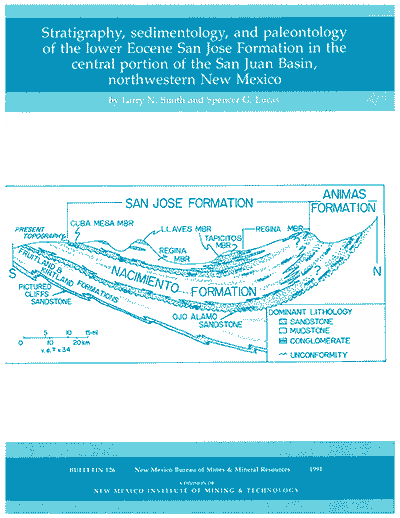
Bulletin 126—Stratigraphy, sedimentology, and paleontology of the Lower Eocene San Jose Formation in the central portion of the San Juan Basin, northwestern New Mexico
By L. N. Smith and S. G. Lucas, 1991, 44 pp., 2 tables, 32 figs., 1 plate, 3 appendices.

In this bulletin, the authors report on the stratigraphy and paleontology of that part of the San Jose Formation that lies between its southern and northern outcrop areas. The authors also include a discussion of the sedimentology of these strata, a subject which has not been reported for any part of the San Jose Formation. This bulletin of the San Jose is part of an effort to decipher the basin-wide stratigraphy of the unit, which will help to determine the (1) paleogeographic controls on the distribution of facies throughout the basin, (2) stratigraphic relationships between the contiguous Paleocene Animas and Nacimiento Formations and the San Jose, (3) stratigraphic relationships between members of the San Jose, (4) completeness of the rock record in the northern versus the southern San Juan Basin, and (5) physical stratigraphy of paleontological sites.
The San Jose Formation in the central portion of the San Juan Basin consists of the Cuba Mesa, Regina, Llaves, and Tapicitos Members. Well-log data indicate that, from its 100 m thickness, the Cuba Mesa Member thins towards the center of the basin and pinches out to the northeast. The Regina Member crops out most extensively in the study area and decreases in sandstone-to-mudrock ratio to the north. The Llaves and Tapicitos Members occur only in the highest locales of the area, are thin due to erosion, and are not mapable as separate units.
The San Jose Formation of the San Juan Basin is the most extensively preserved and exposed Eocene rock-stratigraphic unit in NM. The formation has yielded one of the largest and most diverse vertebrate faunas of early Eocene are collected in North America. The southern and southeastern outcrop area of the San Jose has received the most geologic study. These previous studies included descriptions of fossils and local physical stratigraphic studies and regional mapping. Strata correlative to the San Jose in the northern and northeastern San Juan Basin, Colorado, were described and mapped before the details of the stratigraphy of the San Jose were worked out to the south.
Fossil plants from lacustrine strata of the Regina Member at Santos Peak indicate a humid, forested environment in the depositional basin. Fossil vertebrates from the Regina Member support correlation with the Almagre local fauna of the Regina Member in the east-central San Juan Basin and are thus indicative of a middle Wasatchian (Lysitean) age, about 53 Ma. The fossil mammal taxa included Phenacolemur praecox, Oxyaena forcipata, Ectoganus gliriformis, Esthonyx bisulactus, Coryphodon molestus, Hyopsodus miticulus, Phenacodus primaevus, and Hyracotherium angustidens.
$8.50
Buy
Now
Also available as a free download.
Download
| File Name | Size | Last Modified |
|---|---|---|
| B126.pdf | 10.10 MB | 01/15/2021 11:07:04 AM |



